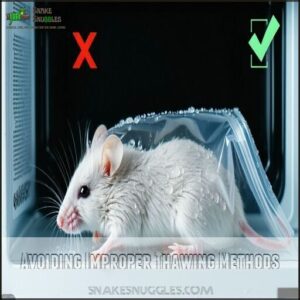This site is supported by our readers. We may earn a commission, at no cost to you, if you purchase through links.

Your snake needs properly warmed food (90-95°F) that mimics live prey.
Try brain scenting or wiggling the prey with tongs to trigger feeding responses.
Maintain proper enclosure conditions—correct temperature gradients and humidity levels are vital for appetite.
Sometimes your snake may be stressed, shedding, or going through seasonal fasting periods.
Don’t panic if they skip a few meals; ball pythons can go weeks without eating.
Simple adjustments in your feeding routine often solve the problem when your stubborn serpent gives frozen meals the cold shoulder.
Table Of Contents
- Key Takeaways
- Ball Python Feeding Issues
- Reasons for Not Eating Frozen
- Thawing and Warming Prey
- Encouraging Eating in Ball Pythons
- Health Checks and Veterinary Care
- Frequently Asked Questions (FAQs)
- Do ball pythons eat frozen food?
- Why does my ball python not eat?
- Can ball pythons eat after shedding?
- Can a ball python eat a frozen rat?
- Can a ball python eat if its enclosure is too cold?
- How long can a ball python go without food?
- What if my ball python refuses to eat frozen food?
- What to do with frozen mouse if snake doesn t eat?
- What to do if a ball python won’t eat?
- How do you thaw a frozen mouse ball python?
- Conclusion
Key Takeaways
- Check your ball python’s enclosure—ensure proper temperature gradients (90-95°F basking, 75-80°F cool side), humidity levels (50-60%), and secure hides to reduce stress.
- Thaw frozen prey properly in the refrigerator overnight and warm it to 100-105°F using a heat lamp or hairdryer for optimal feeding response.
- Mimic live prey with wiggling or scenting techniques like using chicken broth or gerbil bedding to make the frozen food more enticing.
- Be patient and monitor your python’s health; long fasting is natural, but consult a reptile vet if refusal persists or illness symptoms appear.
Ball Python Feeding Issues
You’ll quickly learn that ball pythons can be surprisingly picky eaters, often refusing frozen prey due to temperature, scent, or environmental stress.
When your snake turns its nose up at thawed rodents, don’t worry—the right adjustments to your feeding technique can transform a stubborn snake into an enthusiastic eater.
Common Reasons for Refusal
Many ball pythons refuse frozen prey due to specific triggers.
Your snake might be rejecting meals because of improper prey acclimation, inconsistent feeding schedule, or insufficient enclosure security.
Handling stress before meals often causes refusal.
Incorrect temperatures make prey less detectable to your snake’s heat-sensing pits.
Watch for brumation signs during winter months.
New environments can also cause temporary fasting while your ball python adjusts.
Decreased appetite is often the first sign of ball python illness, which may indicate a need for closer observation of your snake’s health and feeding schedule.
Importance of Proper Husbandry
When your ball python refuses frozen food, proper husbandry is often the real culprit.
Your enclosure setup directly impacts feeding behavior and stress levels.
Five husbandry factors that affect feeding:
- Enclosure Size – minimum 20-30 gallons for adults
- Temperature Gradient – 90-95°F basking area, 80°F ambient
- Hides Essential – one on each side for security
- Substrate Choice – clean, appropriate bedding
- Humidity Levels – daily light misting
Environmental Factors Affecting Appetite
Your snake’s environment directly impacts its appetite.
Check your enclosure setup for these common issues:
- Is your enclosure size appropriate?
- Have you provided hides on both warm and cool sides?
- Are temperature gradients consistent (88-92°F basking area, 75°F cool side)?
- Is humidity between 50-60%?
- Is your substrate type clean and appropriate?
When a ball python’s not eating, these environmental factors are often the culprit, causing stress.
Reasons for Not Eating Frozen
Your ball python isn’t just being stubborn when it turns up its nose at frozen prey.
Understanding the root causes like health issues, improper thawing techniques, or seasonal behavior changes will help you solve this common feeding problem more effectively, by tackling the underlying reasons such as improper thawing techniques.
Parasites and Disease
When your ball python turns down frozen meals, hidden health issues could be the culprit.
Internal parasites like worms often cause refusal to eat, while external parasites create discomfort that suppresses appetite.
Watch for disease warning signs such as respiratory infections, mouth rot, or viral infections that affect feeding behavior.
If your python hasn’t eaten for weeks, it’s time to consult a veterinarian for proper diagnosis and treatment.
Stress and Temperature
While parasites might explain your pet’s eating problems, stress and temperature issues often play a bigger role.
Your ball python not eating frozen prey could signal an uncomfortable environment. Check your enclosure security—loose lids or busy room placement can trigger stress.
Proper thermal gradient is vital, with a 90-95°F basking spot. Excessive handling stress before feeding can also decrease appetite.
Use temperature monitoring tools to verify heating issues aren’t causing your snake’s reluctance. To further encourage feeding, consider that inadequate prey presentation can deter snakes, and proper thermal gradient and enclosure security are crucial for a healthy appetite, as well as avoiding excessive handling.
Seasonal Changes and Brumation
Just as temperature issues affect eating habits, your ball python’s internal clock might be telling it to take a break.
Seasonal changes often trigger brumation, causing a winter fasting period. When light cycles shorten and temperatures drop, your snake’s metabolism slows dramatically.
This natural hunger strike isn’t cause for alarm—it’s normal seasonal behavior. Just maintain proper care during these predictable cycles, and your python will resume eating when ready, following its own internal clock.
Thawing and Warming Prey
You’ll need to properly thaw and warm your ball python’s prey to trigger their natural feeding response.
Frozen mice should be thawed in the refrigerator for 24 hours then warmed to 100-105°F to mimic the body temperature of live prey that your snake’s heat-sensing pits are designed to detect, which is crucial for triggering their natural feeding response.
Proper Thawing Techniques
Now that we’ve a grasp of why your ball python might refuse frozen prey, let’s fix the first common mistake: improper thawing.
Always thaw frozen-thawed prey in your refrigerator overnight—never at room temperature where bacteria multiply quickly.
For quicker defrosting, use warm (not hot) water, avoiding boiling water which can cook the prey. Many owners source rodent thawing supplies to assist.
Check for complete thawing by feeling for cold spots, especially in thicker areas. Proper thawing maintains prey texture and nutritional impact while addressing safety concerns and ensuring the best outcome for your pet, through complete concepts.
Warming Prey for Feeding
After properly thawing your frozen-thawed prey, warming it to the ideal temperature is vital for feeding success.
Heat the rodent to 100-105°F using a heat lamp or hairdryer, which mimics live prey’s body temperature. A frozen rodent warmer can help achieve consistent temperatures.
Always warm gradually to preserve nutritional impact and improve prey palatability. Your ball python’s heat-sensing pits detect this warmth, making the meal more enticing than cold food.
Never microwave prey—it creates dangerous hot spots. This improper heating method can negatively impact the feeding process, and it is crucial to avoid it for the health and well-being of your ball python, ensuring a successful and safe feeding experience.
Avoiding Improper Thawing Methods
During thawing, never use microwaves or hot water for your frozen-thawed prey.
These methods can cause ruptured prey items and bacterial growth, making them unsafe for your ball python.
Always allow proper thawing time in the refrigerator (24 hours) followed by gradual warming to preserve nutritional value.
Quick-thawing shortcuts affect prey temperature and can lead to nutritional loss, which might be why your snake refuses the frozen thawed meal.
Encouraging Eating in Ball Pythons
You can transform your picky ball python into a willing eater with a few simple tricks that mimic their natural hunting instincts.
Creating a stress-free feeding environment while varying prey options will often convince even the most stubborn snake to accept frozen meals.
Offering Variety in Prey
Many ball pythons develop strong preferences for specific prey items.
Offering variety can reignite their feeding response when frozen-thawed meals are being refused.
Here are 5 proven approaches to vary your python’s menu:
- Try different prey sizes (10% of snake’s weight is ideal)
- Experiment with scenting prey using gerbil bedding or chicken broth
- Introduce alternative prey like African soft-furred mice
- Switch prey types gradually to prevent complete refusal
- Rotate between rats and mice to guarantee complete nutrition
If feeding refusal continues and the snake experiences significant weight loss, intervention may be necessary to prevent serious health issues and ensure the snake’s overall well-being and optimal health.
Creating a Stress-Free Environment
Beyond offering different prey types, your ball python needs a calm environment to feel secure enough to eat.
Keep the enclosure in a quiet area with minimal ambient noise and traffic. Provide at least two hiding places—one on each temperature gradient.
Limit handling frequency before feeding days. Proper enclosure size prevents stress, while visual security (covering part of the tank) helps shy pythons feel protected.
A proper hide selection is essential for their security. Maintaining correct temperature and humidity completes their stress-free dining experience.
Using Tease Feeding Techniques
Now that your ball python feels safe, you can try tease feeding techniques.
Gently touch your snake’s snout with the prey to trigger a defensive strike reaction. This mild irritation often kickstarts their feeding response.
After they strike, immediately place them in a dark, secure container like a pillowcase for 15-20 minutes.
This pillowcase technique helps your python feel safe enough to fully consume their frozen-thawed prey without interruptions.
Health Checks and Veterinary Care
You’ll need to check your ball python for signs of illness if it consistently refuses frozen prey, as health problems can affect appetite long before other symptoms appear.
Getting a reptile vet to examine your snake will rule out parasites, respiratory infections, or other conditions that might be causing your feeding troubles, which can be related to health problems.
Monitoring for Signs of Illness
While encouraging your ball python to eat is important, watching for illness signs is equally essential.
Check for weight loss, lethargy signs, and discolored feces regularly. Monitor breathing issues like wheezing or open-mouth breathing.
Pay attention to incomplete shedding problems, which often indicate underlying health issues. These symptoms, especially when paired with appetite loss, suggest stress signs, disease, or internal parasites that require immediate attention.
Don’t ignore these warning signals, as they can be critical indicators of your pet’s health, and immediate attention is necessary to prevent further complications.
Common Health Issues in Ball Pythons
While monitoring your ball python’s health, you need to know what problems to watch for.
Common health issues include respiratory infections (listen for wheezing or see if breathing becomes visible), shedding problems from low humidity, parasites causing weight loss despite eating, obesity from overfeeding, and fatal IBD.
Watch for symptoms like discharge from the nose, stuck shed, diarrhea, or unusual lethargy as these signal disease that might explain feeding refusal, which can be a sign of a serious underlying issue, such as fatal IBD.
Importance of Regular Veterinary Check-Ups
While monitoring health issues at home helps, regular check-ups with a reptile veterinarian catch problems early.
Schedule visits twice yearly for preventative care and parasite screening, even when your snake seems healthy.
Your vet can review husbandry practices and provide expert advice specific to your ball python’s needs.
Many snake health issues develop slowly and are easily missed until they become serious, which is why it’s crucial to address feeding problems promptly.
A vet can also provide guidance on snake skin infections, helping you ensure the best care for your pet.
Don’t wait until issues persist for months, as early intervention is key to preventing serious health issues and ensuring your snake receives the best possible care.
Frequently Asked Questions (FAQs)
Do ball pythons eat frozen food?
Yes, ball pythons can eat frozen food, but it must be properly thawed and warmed first.
Many snakes adapt to frozen-thawed prey, though some may initially prefer live food until trained otherwise.
Why does my ball python not eat?
Your snake might skip meals if it’s stressed, shedding, or adjusting to a new environment.
Health issues or improper temperatures could also play a role.
Check its enclosure and monitor signs of illness.
Can ball pythons eat after shedding?
After shedding, ball pythons often regain their appetite and may eat with enthusiasm.
Shedding can be stressful, so make certain their environment is comfortable, with proper humidity and hides, to help them feel secure.
Can a ball python eat a frozen rat?
Ball pythons can eat frozen rats, but you’ll need to thaw and warm them properly.
Make certain the rat feels warm to the touch, around 100°F, to mimic live prey and spark interest.
Can a ball python eat if its enclosure is too cold?
When temperatures drop, a ball python’s appetite often follows suit.
Cold enclosures slow their metabolism, making them uninterested in food.
Keep the warm side at 90-95°F to encourage eating and proper digestion.
How long can a ball python go without food?
Ball pythons can go months without food, thanks to their slow metabolism.
Healthy adults might fast for 6-12 months, but it’s best to monitor weight, hydration, and consult a vet if signs of illness appear.
What if my ball python refuses to eat frozen food?
When your snake snubs frozen food, it’s like rejecting leftovers—sometimes it’s about temperature or scent.
Try warming prey to 100°F, scenting with chicken broth, or offering variety.
Patience wins; hunger often changes minds, and with patience, you can find the right approach.
What to do with frozen mouse if snake doesn t eat?
Refreeze the mouse only once, storing it in an airtight bag to avoid contamination.
If not, discard it.
Avoid leaving uneaten prey in the cage too long, as it can cause odors or stress.
What to do if a ball python won’t eat?
Did you know up to 60% of ball pythons occasionally refuse food?
Don’t panic—check temperatures, offer live-scented prey, or try warming frozen ones more.
Stress-free environments and patience usually work wonders over time.
How do you thaw a frozen mouse ball python?
Start by thawing the frozen mouse in a refrigerator overnight.
Warm it to 100-105°F using a reptile heat lamp or hairdryer.
Make certain it’s completely dry, as wet prey might discourage your snake from eating.
Conclusion
A hesitant ball python not eating frozen prey can feel like hitting a wall, but small changes often lead to big results.
Focus on proper thawing, warming, and presentation to make the food irresistible.
Check your snake’s enclosure for stress triggers and maintain ideal conditions.
If appetite issues persist, consult a reptile-savvy vet to rule out health problems.
With patience and adjustments, your snake will likely come around to frozen meals, keeping it healthy and thriving.
- https://books.google.com/books?hl=en&lr=&id=INMPBgAAQBAJ&oi=fnd&pg=PA3&dq=ball+python+eating&ots=QdLOGNh-X2&sig=e4ZWJc8OnrQuTAZgJsTQ42MkLMI
- http://www.anapsid.org/ballfeed.html
- https://jkrballstreetjournal.com/2014/02/12/the-psychology-of-problem-feeders-get-your-ball-python-eating-again/
- https://science.psu.edu/news/stressed-snakes-strike-first
- https://www.researchgate.net/publication/231767153_Spinicauda_regiensis_n_sp_Nematoda_Heterakoidea_a_parasite_of_the_ball_python_Python_regius















